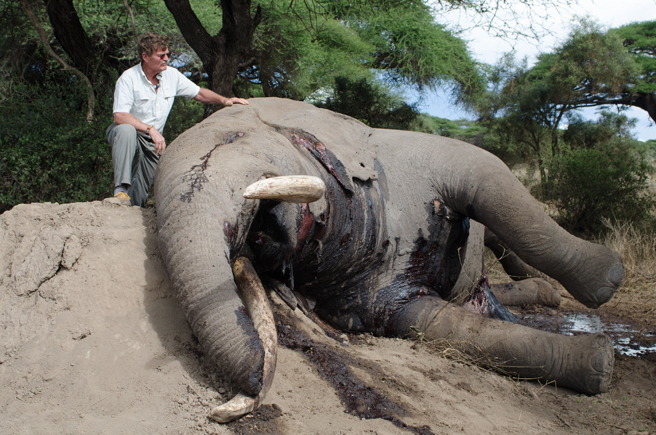AWF’s Board Chair Remembers Satao

I was heartbroken when I heard the news about the death of Satao, a mighty bull elephant recently killed by poachers in Kenya’s Tsavo National Park.
It is unfortunate that Satao should survive the poaching wars of the 1970s and 1980s as a young bull only to fall prey to a poacher’s poisoned arrow 45 years later as a mature bull. Never again will those lovely curved tusks sweep back and forth above the Tsavo grasses. Instead, Satao’s tusks, if not intercepted by authorities, will likely end up displayed motionless on a mantle in Asia somewhere.
Though I never had the honor or pleasure of seeing Satao in the wild, he and I both began stomping around Africa about the same time in the 1970s. I have seen many elephants in the wild during the time I’ve spent there, but I can recall only once, a couple of years ago, coming across a big tusker like Satao. Sadly, this 50-year-old bull had also been killed, though not by poachers in pursuit of his ivory tusks but because he had been raiding crops near Amboseli National Park. It’s a grisly reminder of how vulnerable even our giants are, and how humans hold their fate in our hands.
Satao wasn’t the first big tusker to be killed by poachers. Only weeks before, another of Kenya’s legendary elephants, Mountain Bull, was speared to death before his tusks were hacked from his head. What strikes me is that, unlike so many elephants in Africa’s large landscapes that seem to disappear without a trace, these two bulls were closely monitored by wildlife authorities and conservation groups. Mountain Bull wore a GPS collar and had been partially de-tusked by authorities. Satao was well-known and tracked regularly from the ground and air. And both bulls were killed inside two of Kenya’s national parks, where they should have been well-protected and out of reach from poachers.
This is to say we clearly need to do more if two of our most beloved and famous elephants can be taken from under our noses. AWF is working with partners to increase anti-poaching operations, decrease trafficking of wildlife parts, and enhance law enforcement around wildlife crimes in Africa, and we are also campaigning in target countries where the demand for ivory stems. If we want to spare the sisters and brothers, sons and daughters, grandsons and granddaughters of Satao and Mountain Bull the same fate these bulls suffered, we have to protect the elephants at source while deflating completely the market for ivory overseas. We all must fight for the survival of the giants.